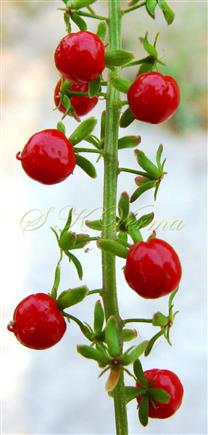PHYTOLACCACEAE
Herbs, shrubs, lianas or trees, annual or perennial. Leaves alternate, simple, entire. Stipules absent or minute. Inflorescences cymes or racemes. Flowers bisexual, rarely unisexual (plants monoecious), usually small, actinomorphic. Perianth mostly uniseriate, composed of calyx of 4-5, usually more or less connate, persistent. Petals absent, sometimes staminodes petaloid. Stamens 3-30(-100), often borne on hypogynous disc in one or more (commonly 2) whorls; the outer whorl of petaloid staminodes, alternate or opposite the calyx lobes; filaments free or basally connate, anthers bithecous, dorsifixed, dehiscence longitudinal. Gynoecium 1-18 carpellate, syncarpous or apocarpous; when gynoecium of one carpel or 2- many free carpels then ovary unilocular with solitary basal ovule, styles absent or small, erect or curved, stigma 1 per carpel, linear to filiform (capitate or peltate in Rivina); when 2-many carpellary, syncarpous, then ovary is 2-18-locular, placentation axile, style short or none, stigmas as many as carpels, linear to filiform. Fruit variable: schizocarp, berry, drupe, achene. Seeds with large curved embryo.
The members (7 genera) of the tribe Rivineae with monocarpellate pistils have been segregated into a separate family Petiveriaceae (9 genera and 23 species) by some workers.
